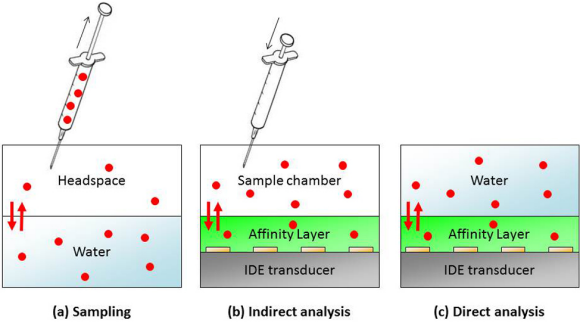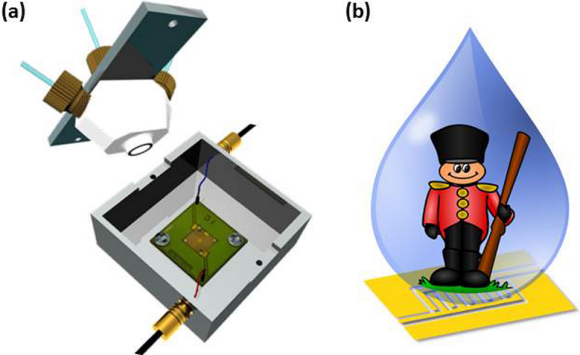
Interdigitated electrodes (IDEs) have proven to be an attractive transducer platform to fabricate capacitive sensor devices that have been applied to measure humidity, fluid levels or gas compositions. Changes in the surrounding dielectric properties, for example due to the presence of gas species, affect the electrical field that is established by the IDE electrodes and hence also the capacitance. IDEs can be covered with polymer layers that act as an affinity layer. When making such layers for sensor purposes, full specificity for one target is highly desired.
Depending on the target compound, the use of biomaterials and (bio-inspired) synthetic materials may achieve this. Alternatively, an array of IDEs, each covered with a different, not fully specific coating can be used to pursue pattern recognition and multicomponent analysis.
An interesting class of target compounds is the one of volatile organic compounds (VOCs), which can also be present as a contaminant in water. When dissolved, VOCs partition between the liquid phase and the gas phase (figure 1a).

Figure 1: Schematic overview of sampling from the headspace (a), followed by the indirect analysis using an IDE transducer (b). The system under study (c) represents the direct analysis in the aqueous phase.
As a result, by sampling and analyzing the gas phase above an aqueous solution, information about the water composition can be obtained (Figure 1a and b). While this indirect way of sensing, also known as headspace technology, is very useful for VOCs indeed, it is not or at least less suitable for compounds with a relatively low vapour pressure. For this reason, we have studied IDE sensors directly in water at Delft University of Technology in strong collaboration with Wetsus, European centre of excellence for sustainable water technology in the Netherlands (Figure 1c).1
Next page
Water is an electrically challenging environment as it has a relatively high dielectric constant and a high conductivity, especially when it contains salts. Therefore, the immersion of IDEs in water may cause unpredictable parasitic coupling to the surrounding and other system parts, requiring more care in the interpretation of capacitive responses. At the same time, appropriate measures can be taken when designing and fabricating the IDE platform.
The Dutch TUD/Wetsus sensor system consists of a micrometer-sized IDE with in-plane guarding electrodes. The chip was mounted onto a PCB and covered with a coating of polydimethylsiloxane that has a thickness in the range of dozens of micrometers. The sensor was placed in a holder facilitating the proper alignment of a Teflon flow cell and allowing all required electrical and flow connections (Figure 2a). Measurements were performed using a LabVIEW-supported universal transducer interface (UTI) with a resolution of about 500 aF.

Figure 2: Schematics of the flow cell and cell holder with electrical and flow connections (a) and a cartoon on the topic of water-enhanced guarding (b).
Using this system we have shown that, with proper care, the water phase can be considered as being an electrode itself (reference 1). As such, coupling to guarding electrodes protects an immersed IDE sensor sensitive device from being influenced by unwanted changes in the environment, the effects of interfering signals, and from variations in the conductivity of water (Figure 2b). Interestingly, this can be achieved without impairing the detection performance of the polymer-coated IDE device.
Next page
Additionally, we studied the capacitive response of the deposition and evaporation of drops of a series of pure VOCs and to the direct exposure to aqueous solutions of these VOCs (up to 1 Millimolar) under continuous flow conditions (reference 2). The series includes methyl tert-butyl ether (MtBE), a fuel oxygenate and other fuel hydrocarbons, such as toluene and m-xylene. The capacitive response changes were found to be in line with their relative dielectric constants in relation to the one of the thin PDMS affinity layer. Furthermore, all response changes were fully reversible.
Our work contributes to the knowledge of capacitive response interpretation and mechanisms and points out important design considerations for improved sensing systems, in particular for applications in aqueous environments such as droplet and flow detectors for biomedical and environmental fields. To conclude, compared to gas-phase applications, immersing IDEs in water induces additional effects that make the capacitive read-out extremely complex. We have now made a virtue of a necessity, simply by applying the water phase as an electrode and making it couple to guarding electrodes in a controlled way.
References
1) Water-enhanced guarding of polymer-coated IDE platforms as a key mechanism for achieving response immunity towards parasitic coupling events.
2) Capacitive response of PDMS-coated IDE platforms directly exposed to aqueous solutions containing volatile organic compounds.
About the Author
Dr L.C.P.M. (Louis) de Smet received the M.Sc. degree in Molecular Sciences (2001) and the Ph.D. degree in the field of organic monolayers (2006) from Wageningen University, the Netherlands. He then worked as a postdoctoral researcher on plasma polymers with Ian Wark Research Institute at the University of South Australia. In 2007, he was appointed as an assistant professor with the Department of Chemical Engineering, Delft University of Technology, The Netherlands. His research interests include the preparation and characterization of functional organic monolayers and polymer films and their application to the surface of membranes and different sensor platforms, including nanowire-based sensors and interdigitated electrodes. For more information, visit http://www.louisdesmet.com.
Related Stories
'Shapeability' for Custom Position Sensors Requirements
DuPont Microcircuit Materials to Debut Innovative New Inks
Touch the revolution with the most noise-immune capacitive touch microcontroller (MCU)